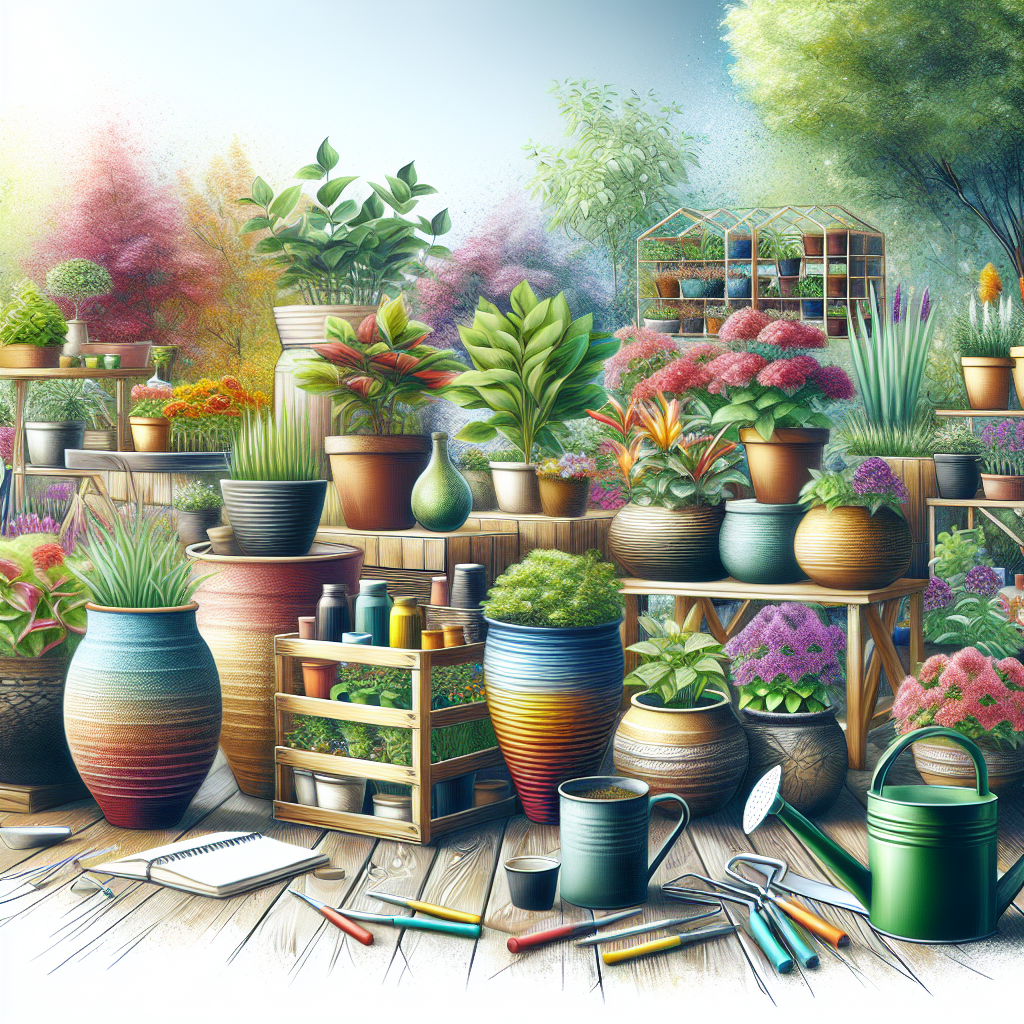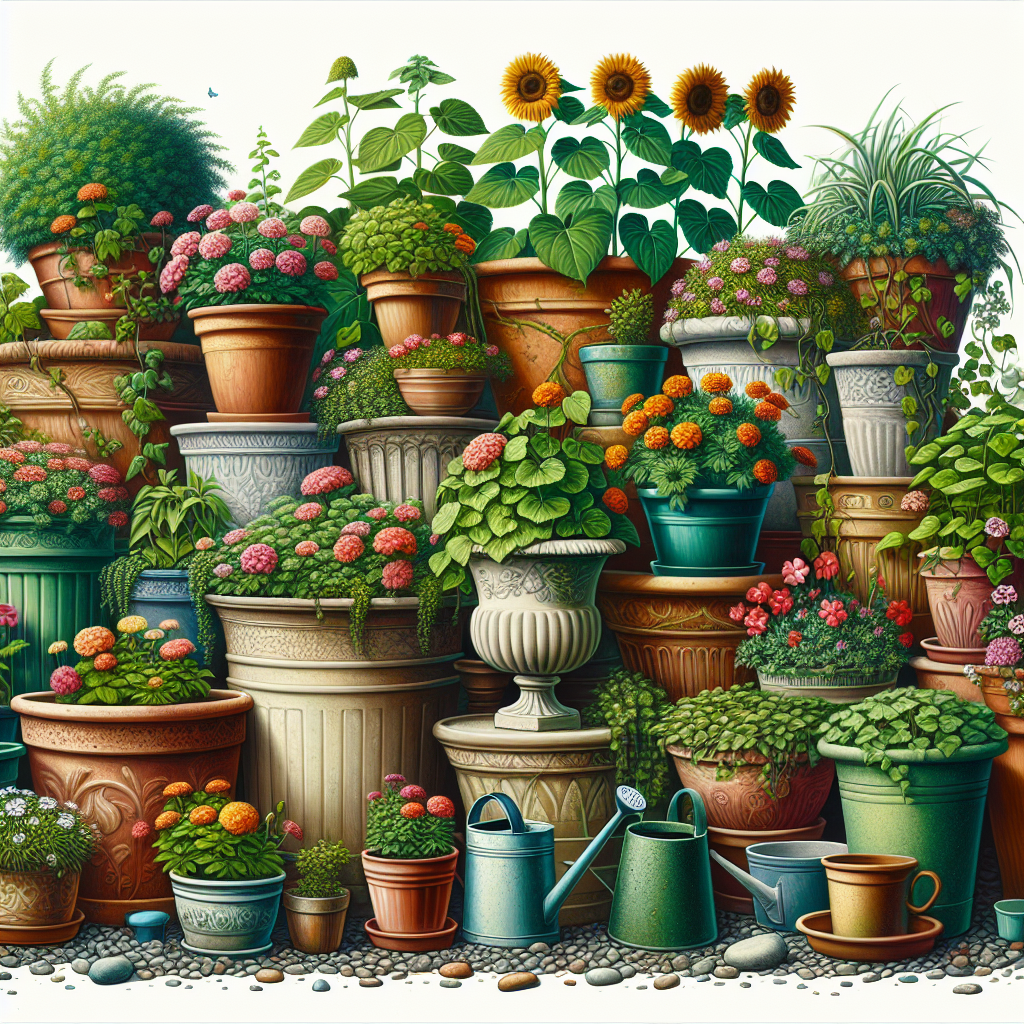
If you’re looking to bring some greenery into your outdoor spaces but don’t have a lot of room to work with, container gardening might just be the perfect solution for you. Whether you have a tiny balcony or a small backyard, this method allows you to create a beautiful and thriving garden using containers. In this article, we will share some handy tips to help you succeed in container gardening. From choosing the right containers to selecting the perfect plants and ensuring proper care, we’ve got you covered. Get ready to embark on a rewarding gardening journey that will brighten up your surroundings and bring joy to your green thumbs!
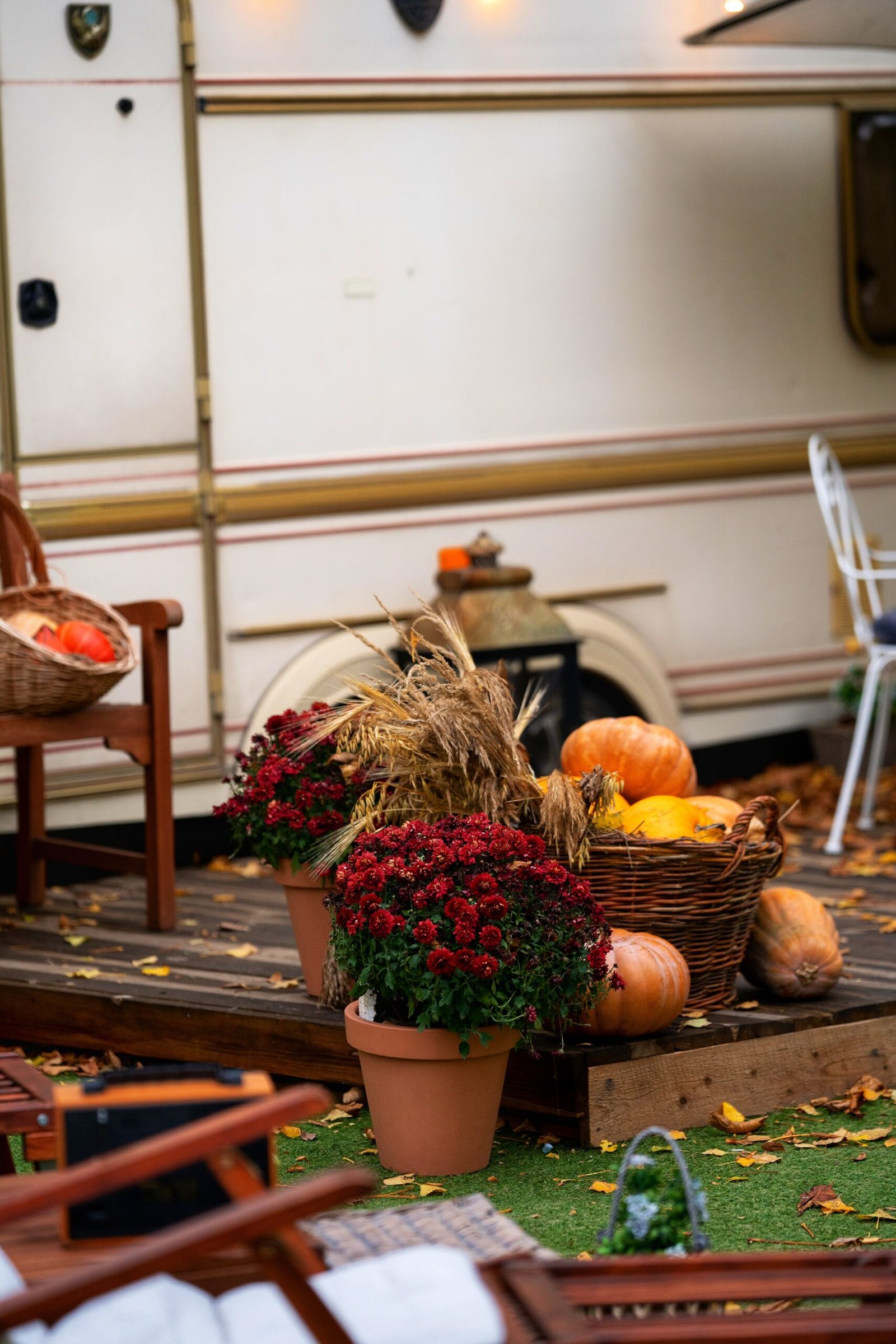
Choosing the Right Containers
Consider the Size and Depth
When it comes to choosing containers for your plants, size and depth matter. The size of the container should be proportionate to the mature size of the plants you intend to grow. Plants with extensive root systems will require larger containers, while smaller or shallow-rooted plants can thrive in smaller pots.
Consider the depth of the container as well. Plants with deep root systems will benefit from containers that provide ample depth for root expansion. On the other hand, plants with shallow root systems can do well in shallower containers.
Choose the Appropriate Material
The material of the container also plays a vital role in the success of your container garden. Different materials have different pros and cons, so it’s important to choose wisely.
Terracotta and clay containers are popular choices as they are porous and allow for better air circulation. However, they may dry out quickly and may be susceptible to cracking in colder temperatures.
Plastic containers are lightweight and offer better moisture retention, making them a good option for plants that require consistent moisture. However, they may not be as aesthetically pleasing as other materials.
Metal containers, such as galvanized steel or copper, provide durability and can add a stylish touch to your garden. However, they can heat up quickly in direct sunlight, requiring more frequent watering.
Wooden containers have a natural look and good insulation properties. However, they may rot over time, so it is important to choose containers made from rot-resistant wood, like cedar or redwood.
Prioritize Drainage
Drainage is a crucial factor to consider when selecting containers for your plants. Without proper drainage, excess water can accumulate in the soil, leading to root rot and other issues.
Look for containers that have drainage holes at the bottom to allow water to flow freely. If you fall in love with a container that doesn’t have drainage holes, you can create them yourself using a drill.
To ensure proper drainage, elevate your containers slightly by placing them on pot feet or small bricks. This will prevent them from sitting directly on the ground or saucer, allowing excess water to escape.
Selecting the Right Soil
Opt for Well-Draining Soil
Choosing the right soil for your container garden is essential for the health and growth of your plants. Well-draining soil is crucial because it allows excess water to flow through, preventing waterlogged roots.
Avoid using regular garden soil, as it tends to be heavy and may not provide adequate drainage. Instead, look for a high-quality potting mix specifically designed for container gardening. These mixes are usually lightweight and well-aerated, ensuring sufficient drainage.
You can also enhance drainage by adding perlite or vermiculite to the potting mix. These materials help improve aeration and prevent the soil from becoming compacted.
Include Organic Matter
In addition to well-draining soil, it is beneficial to include organic matter in your container garden. Organic matter, such as compost or well-rotted manure, improves soil fertility, enhances moisture retention, and provides essential nutrients for plant growth.
Incorporating organic matter into the potting mix also helps create a loose and crumbly texture, allowing roots to penetrate easily and promoting healthy root development.
Consider adding a layer of organic mulch on top of the soil to further conserve moisture and suppress weed growth. This will also promote a healthy soil ecosystem by attracting beneficial organisms.
Consider pH Levels
A crucial aspect of selecting the right soil is considering the pH levels required by your plants. Different plants thrive in different pH ranges, so it is important to research and choose plants that have similar pH requirements.
Most plants prefer slightly acidic to neutral soil, with a pH level between 6.0 and 7.0. However, there are exceptions, such as acid-loving plants like azaleas and blueberries that require more acidic soil.
You can use a pH testing kit to determine the pH level of your soil and make necessary adjustments by adding amendments. Lime can be added to raise pH levels, while sulfur or aluminum sulfate can be added to lower pH levels.
Maintaining appropriate pH levels will ensure optimal nutrient uptake by the plants and prevent any nutrient deficiencies or toxicities.
Picking the Perfect Plants
Evaluate Sunlight Requirements
Before selecting plants for your container garden, evaluate the amount of sunlight your garden receives. Most plants have specific sunlight requirements, ranging from full sun to partial shade or full shade.
Observe your garden throughout the day and determine which areas receive direct sunlight, partial sunlight, or shade. This will help you make informed choices about the plants that will thrive in your specific garden conditions.
For example, sun-loving plants like tomatoes, peppers, and petunias require at least six hours of direct sunlight per day. On the other hand, shade-loving plants like ferns and impatiens thrive in areas with limited direct sunlight.
Consider the Plant’s Mature Size
Another important consideration when selecting plants is their mature size. While small plants may look adorable in tiny containers, they can quickly outgrow their containers and become rootbound. This can stunt their growth and lead to poor health.
Research the mature size of the plants you are interested in and choose containers that can accommodate their growth. This will ensure that your plants have enough space for root development and can thrive to their full potential.
Consider vertical gardening techniques or choose plants with compact growth habits if you have limited space but still desire a variety of plant options.
Choose Complementary Plants
When selecting plants for your container garden, it is also important to consider how they will complement each other in terms of aesthetics and growth habits.
Choose plants that have similar water and light requirements to ensure they can coexist harmoniously in the same container. This will make watering and maintenance easier for you and promote the overall health of the plants.
Consider combining plants with different textures, colors, and heights to create an eye-catching and visually appealing arrangement. Mixing trailing plants with upright plants or contrasting bold foliage with delicate blooms can create a dynamic and beautiful container garden.
Providing Adequate Watering
Monitor Soil Moisture
Watering is a critical aspect of container gardening, as plants rely on consistent moisture to thrive. It is important to monitor the moisture levels in the soil to avoid both under-watering and overwatering.
Stick your finger about an inch deep into the soil to check its moisture levels. If the soil feels dry at that depth, it’s time to water. If it feels moist, hold off on watering until it dries out a bit.
Remember that different plants have different water requirements, so it’s essential to familiarize yourself with the specific needs of the plants in your container garden. Desert succulents will require less frequent watering compared to thirsty annual flowers.
Water Consistently
Consistency is key when it comes to watering your container garden. Aim to provide a consistent level of moisture throughout the growing season. This means watering your plants regularly, especially during hot and dry periods.
Avoid allowing your containers to completely dry out between waterings, as this can cause stress to your plants. On the other hand, don’t let them sit in waterlogged soil, as it can lead to root rot.
Water your plants thoroughly until you see water seeping out of the drainage holes at the bottom of the container. This ensures that the entire root system is adequately hydrated.
Avoid Overwatering
While it’s important to provide consistent moisture, overwatering can be detrimental to the health of your plants. Overwatering can lead to root rot, fungal diseases, and suffocation of the roots due to lack of oxygen.
Ensure that your containers have proper drainage and that the excess water can freely flow out. Remember that it’s better to underwater slightly than to overwater, as most plants can recover from slight drought stress but struggle to survive in waterlogged conditions.
Keep in mind that the frequency of watering may vary depending on the weather conditions, the size of the container, and the specific water needs of your plants. Adjust your watering schedule accordingly to meet the needs of your container garden.
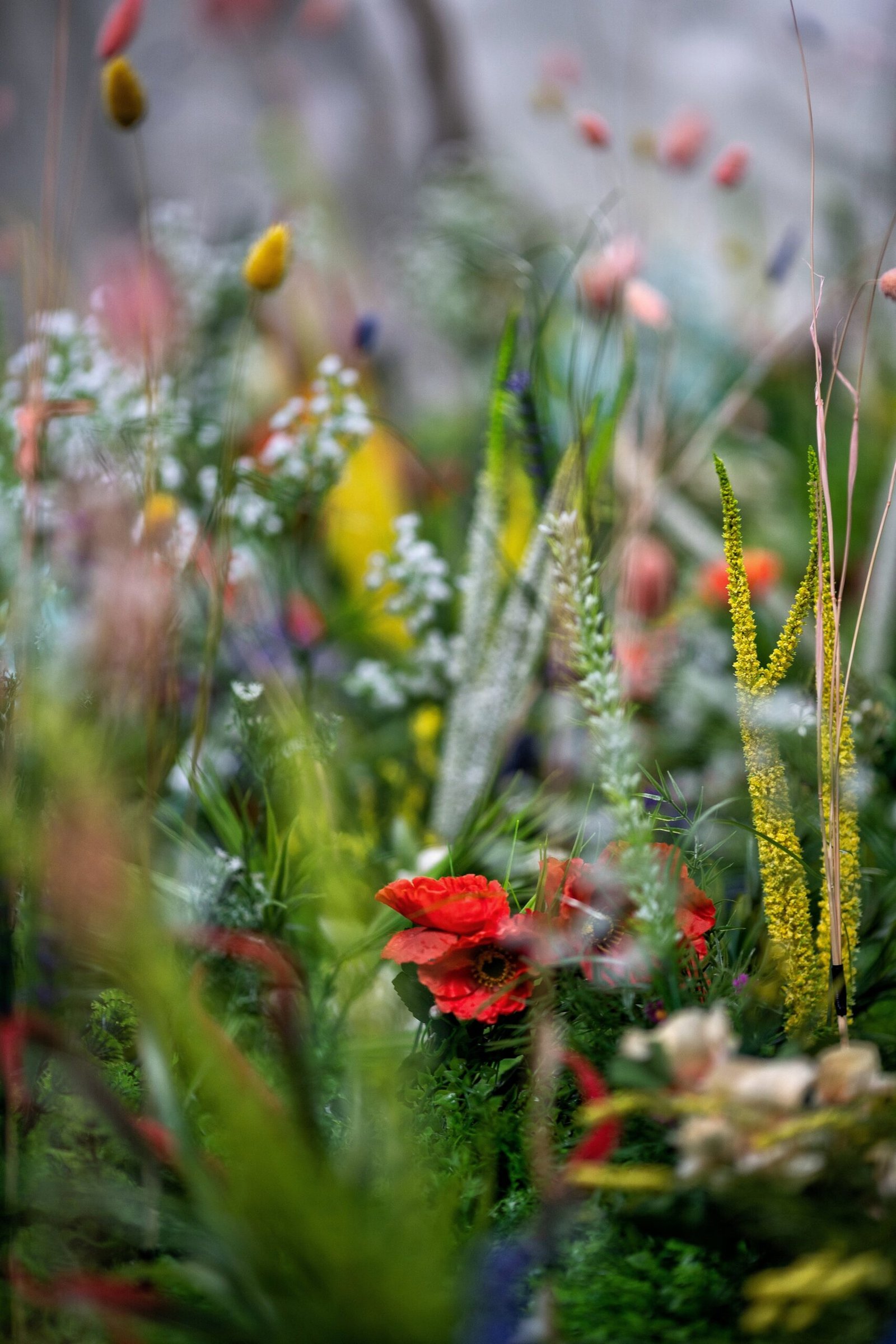
Fertilizing Techniques
Use Balanced Fertilizers
To ensure the health and vigor of your container plants, fertilizers play a crucial role. The nutrient requirements of container plants can be higher compared to those grown in the ground, as the nutrients in containers can quickly get depleted.
Use balanced fertilizers specifically formulated for container plants. These fertilizers provide a mix of essential nutrients, including nitrogen (N), phosphorus (P), and potassium (K), in the appropriate ratios.
Look for fertilizers with a ratio like 10-10-10 or 14-14-14. This means that the fertilizer contains equal proportions of nitrogen, phosphorus, and potassium. This balanced approach ensures that your plants receive all the nutrients they need for overall growth and development.
Follow Application Guidelines
When it comes to fertilizing your container plants, it’s important to follow the application guidelines provided on the fertilizer packaging. Overfertilizing can lead to nutrient imbalances and can be harmful to your plants.
In general, it’s recommended to fertilize container plants every four to six weeks during the growing season. Dilute the fertilizer according to the instructions and apply it to moist soil to prevent root burn.
Avoid applying fertilizer to dry soil, as it can inhibit nutrient uptake by the plants. Water your plants before and after fertilizing to ensure that the nutrients are absorbed properly.
Consider Organic Alternatives
If you prefer to take an organic approach to fertilizing your container garden, there are several options available.
One option is to use compost or well-rotted manure as a natural, slow-release fertilizer. These organic materials enrich the soil with nutrients over time and improve its overall fertility.
You can also make your own organic liquid fertilizer by steeping compost or well-rotted manure in water for a few days. Use this nutrient-rich solution to water your container plants, providing them with a natural boost.
Organic seaweed or fish emulsion fertilizers can also be used to provide a nutrient boost to your container plants. These natural fertilizers are rich in macro and micronutrients and are readily absorbed by plants.
Managing Pests and Diseases
Implement Preventive Measures
Prevention is always better than cure when it comes to managing pests and diseases in your container garden. By implementing preventive measures, you can reduce the chances of infestations or diseases spreading.
Regularly inspect your plants for signs of pests or diseases. Catching problems early can help prevent them from becoming major issues.
Keep your containers and gardening tools clean to minimize the risk of pests or diseases being introduced to your garden. Remove any debris or dead plant material, as they can attract pests and harbor diseases.
Consider using physical barriers such as row covers or netting to protect your plants from common pests like aphids or caterpillars. These barriers create a physical barrier that insects cannot penetrate, reducing the chances of infestations.
Identify Common Pests
Knowing the common pests that can affect container plants can help you take appropriate measures to prevent or manage them.
Aphids are small, soft-bodied insects that can quickly multiply and suck sap from plant tissues. They can cause stunted growth and transmit diseases.
Spider mites are tiny arachnids that feed on plant sap and can cause discoloration, webbing, and overall decline of the plants.
Whiteflies are small insects that resemble tiny moths. They feed on plant sap and can cause leaf yellowing, wilting, and the development of a sticky substance known as honeydew.
Slugs and snails are common pests that can chew on plant leaves, leaving behind unsightly holes and damage.
Address Plant Diseases
In addition to pests, container plants can also be susceptible to various diseases. Identifying and addressing plant diseases promptly can help prevent their spread and minimize damage.
Common plant diseases include fungal infections like powdery mildew, which appears as a white, powdery coating on leaves, stems, and flowers. Fungal diseases thrive in moist conditions, so proper watering practices can help prevent their development.
Bacterial infections can cause wilting, leaf spots, or rot on plants. Avoid working with plants when they are wet, as this can spread bacterial diseases.
Viral diseases can cause deformities, discoloration, or stunting of plants. There is no cure for viral diseases, so prevention is key. Be careful not to spread viruses by using clean tools and practicing good hygiene.
If you notice any signs of pests or diseases in your container garden, promptly remove and dispose of affected plant parts to prevent further spread. Consider using organic or chemical controls if the infestation or disease becomes severe.

Ensuring Proper Sunlight
Find the Ideal Location
To ensure that your plants receive the proper amount of sunlight, it’s important to find the ideal location for your containers. Observe your garden throughout the day and identify areas that receive the recommended amount of sunlight for your plants.
Most plants require at least six hours of direct sunlight per day to thrive. Place your containers in areas that receive ample sunlight during the day, such as south-facing balconies or sunny spots in your garden.
If you have limited space or your garden receives insufficient sunlight, consider using reflective surfaces, such as mirrors or white walls, to redirect sunlight to your containers. This can help maximize the amount of sunlight your plants receive.
Rotate Containers
Container gardening allows you the flexibility to move your plants around and take advantage of different sunlight conditions. To ensure even growth and prevent one side of the plant from shading the other, periodically rotate your containers.
Rotate your containers every couple of weeks or as needed to ensure that all sides of the plant receive an equal amount of sunlight. This will promote even growth and prevent the plant from leaning toward one direction.
Keep in mind that some plants may be more sensitive to changes in lighting conditions, so monitor their response to rotation and adjust accordingly.
Provide Shade if Necessary
While most plants require adequate sunlight, some may benefit from partial shade, especially during hot summer months. Providing shade can prevent plants from wilting or getting scorched by intense sunlight.
Consider using shade cloths, umbrellas, or other structures to create shade for your containers. Place them strategically to shield your plants during the hottest part of the day, usually between 11 am and 4 pm.
Take care not to provide excessive shade, as plants still need some sunlight to carry out photosynthesis. Monitor your plants and adjust the amount of shade provided based on their response.
Pruning and Trimming
Promote Healthy Growth
Pruning and trimming are essential for maintaining the health and appearance of your container plants. Regular pruning promotes healthy growth, improves air circulation, and prevents the plants from becoming overcrowded.
Use sharp, clean pruning shears to remove any dead, diseased, or damaged plant material. This will not only improve the overall appearance of your plants but also prevent the spread of diseases or pests.
Trimming back leggy or overgrown branches can help shape your plants and encourage bushier growth. Pinch or trim off the tips of the branches to promote branching, resulting in a fuller and more compact plant.
Remove any suckers or water sprouts that may emerge from the base or along the plant stems. These vigorous shoots can divert energy from the main plant and result in weak growth.
Remove Dead or Diseased Material
Regularly inspect your plants for any signs of dead or diseased material. Dead or dying leaves, stems, or flowers can promote the spread of diseases and weaken the overall health of your plants.
Remove any dead or dying material promptly to prevent diseases from spreading to healthy parts of the plant. Make clean cuts just above a leaf node or stem junction to encourage new growth.
If you notice signs of plant diseases, such as leaf spots or moldy growth, remove and dispose of affected plant parts immediately. Thoroughly clean your pruning shears with rubbing alcohol between each cut to prevent cross-contamination.
Shape and Control Size
Pruning is also a useful tool for shaping and controlling the size of your container plants. By selectively removing branches or stems, you can guide the plant’s growth and ensure it fits within the allotted space.
Consider the natural growth habit of the plant and prune accordingly. For example, if you have a trailing plant, you may want to encourage it to cascade over the edges of the container by pruning back any upward-growing branches.
If your container plants start to outgrow their designated space, it’s time to consider root pruning as well. Gently remove the plant from its container, trim back the roots, and repot it in a larger container or divide it into multiple containers if necessary.
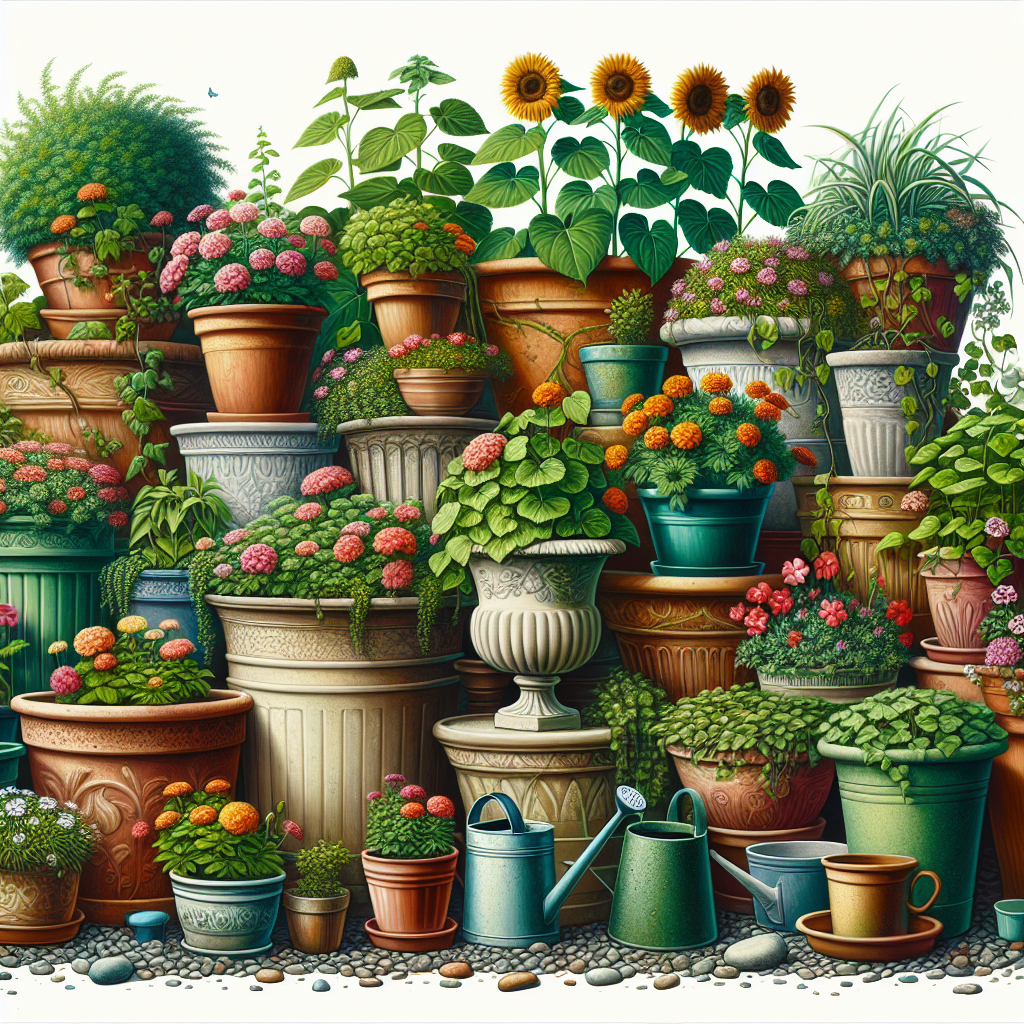
Monitoring and Observing
Inspect for Signs of Stress
Regular monitoring and observation are key to maintaining a healthy container garden. Observing your plants can help you identify any signs of stress or issues before they become severe.
Inspect your plants for any changes in leaf color, wilting, stunted growth, or pest damage. These can be indicators of nutrient deficiencies, water-related issues, or pest infestations.
Check for any physical symptoms such as leaf spots, yellowing, or deformities. These can signal the occurrence of diseases or infections that need immediate attention.
If you notice any signs of stress, take immediate action by adjusting watering, providing appropriate fertilization, or addressing potential pest or disease issues. Early intervention can often prevent further damage to your plants.
Check for Nutrient Deficiencies
Container plants are more susceptible to nutrient deficiencies compared to those grown in the ground, as nutrients can quickly be leached out of the containers. It’s important to check for any signs of nutrient deficiencies and address them promptly.
Common nutrient deficiencies include yellowing leaves (indicating a lack of nitrogen), stunted growth (indicating a lack of phosphorus), or leaf discoloration (indicating a lack of iron or other micronutrients).
If you suspect a nutrient deficiency, consider fertilizing your plants with a balanced, slow-release fertilizer or an appropriate nutrient-specific fertilizer. This will help replenish the nutrients in the soil and promote healthy plant growth.
Regularly monitoring and fertilizing your container plants will ensure that they have access to the necessary nutrients for optimal growth and development.
Keep an Eye on Environmental Conditions
Environmental conditions, such as temperature, humidity, and air circulation, can greatly impact the health of your container plants. It’s important to keep an eye on these factors and make necessary adjustments as needed.
Extreme temperatures can stress or damage your plants. If temperatures drop below the tolerance of your plants, consider bringing them indoors or providing protection, such as covering them with frost cloth or moving them to a sheltered location.
Humidity levels can also affect your plants, especially if they prefer a certain level of moisture in the air. Consider using a humidifier or misting the leaves of your plants to increase humidity in dry indoor environments.
Ensure proper air circulation around your plants to prevent the development of fungal diseases. Avoid overcrowding containers and provide space between plants to allow air to flow freely.
Regularly check the weather forecast and be prepared to make adjustments to your container garden based on any extreme weather conditions. By keeping a close eye on the environment, you can protect your plants from potential harm.
Preparing for Winter
Bring Indoors or Provide Protection
As winter approaches, it is important to prepare your container garden for the colder temperatures. Some plants may not be able to withstand the cold and need to be brought indoors.
Identify the plants in your container garden that are not cold-hardy and need protection. Tropical plants, annual flowers, and herbs like basil are examples of plants that should be brought indoors.
Before bringing your plants indoors, inspect them for any signs of pests or diseases. Isolate any affected plants to prevent the spread of pests or diseases to your other indoor plants.
If bringing all your plants indoors is not feasible, consider using protective measures like frost cloths or mulch to shield them from cold temperatures. Wrapping containers with bubble wrap or burlap can also help insulate the roots and protect them from freezing.
Clean and Store Containers
Once you have made the necessary arrangements to protect your plants, it’s time to clean and store your containers for the winter. Proper cleaning and storage will ensure that your containers remain in good condition for future use.
Empty out the soil from the containers and remove any dead plant material. Scrub the containers with a mild detergent and rinse thoroughly to remove any pests or diseases.
Allow the containers to dry completely before storing them. Moisture left in the containers can lead to the growth of mold or mildew.
Store your containers in a dry, sheltered location to prevent damage from freezing temperatures or excessive moisture. Stack them if possible to save space and ensure they are protected.
Plan for Winter Plantings
While some plants may not survive the winter, there are still options for continuing your container gardening during the colder months. Plan for winter plantings to enjoy fresh greens and blooms even in the winter.
Cold-hardy vegetables like kale, spinach, and lettuce can be grown in containers during the winter. These cool-season crops thrive in cooler temperatures and can provide you with fresh produce throughout the winter months.
Consider adding winter-flowering plants like pansies, flowering kale, or hellebores to your container garden. These plants can add a splash of color to your outdoor space during the winter and provide nectar for any visiting pollinators.
Research the specific requirements of the plants you choose for your winter plantings, as they may have different sunlight and temperature preferences compared to warm-season plants.
By planning for winter plantings, you can extend the joy of container gardening throughout the year and make the most of your outdoor space even during the colder months.
Container gardening is a versatile and rewarding way to bring plants into your life, regardless of the space available to you. By considering the size and depth of your containers, choosing the right soil and plants, providing adequate watering and care, and addressing pests and diseases, you can create a thriving container garden. Monitoring and observing your plants, as well as preparing for winter, will ensure that your container garden remains healthy and vibrant year-round. So go ahead and embark on your container gardening journey – you’ll be amazed at the beauty and joy it can bring to your life. Happy gardening!
